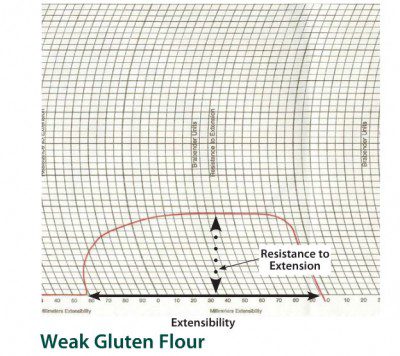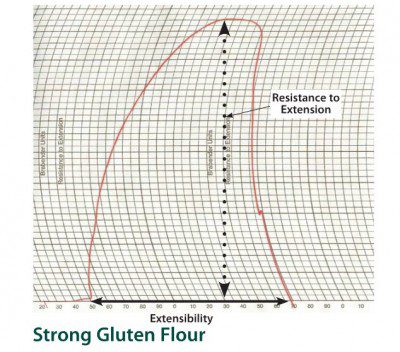Function
Information on the extensional properties of bread dough is read directly from the diagram of the extensograph curve, also referred to as the extensogram. The extensogram represents changes in resistance, also called the strength, of the dough to extension (R) as a function of the extension distance (E).1 See figure 1 comparing a strong gluten dough to a weak gluten dough.2

Figure 1
Resistance to Extension (R) is indicated by the maximum height of the curve and measured in centimeters, Brabender units (BU), or Extensograph units (EU).2
Extensibility (E) is indicated by the length of the curve. It is measured in millimeters or centimeters.2
R/E Ratio indicates the balance between dough strength (R) and the extent to which the dough can stretch before breaking (E).2
Area Under the Curve is a combination of resistance and extensibility. It is expressed in square centimeters.2
Process
A sample of flour- water-salt dough pieces of constant weight and of the appropriate water absorption are prepared using the Farinogrph.3 The Farinograph measures flour- water absorption and dough strength.2
The dough piece is rounded and molded into a cylinder under constant conditions.3 Each piece is then pegged into a cradle and allowed to rest at a controlled temperature.3 The piece is extruded by a hook which travels downwards at a constant rate.3 The load on the dough piece is recorded and the extensograph curve is obtained.3
Application
Results from an extensograph are useful in determining the gluten strength and bread-making characteristics of flour.2 Changes to formulas such as fermentation time, type of flour or new supplier, dough additives can all be evaluated by an extensograph.
References
- Antoni, Miś, and Dariusz Dziki. “Extensograph Curve Profile Model Used for Characterising the Impact of Dietary Fibre on Wheat Dough.” Journal of Cereal Science 57.3 (2013): 471-479.
- “Section 4: Flour and Dough Tests.” Wheat and Flour Testing Methods: A Guide to Understanding Wheat and Flour Quality, Version 2. Manhattan, Kan.: Kansas State U Agricultural Experiment Station and Cooperative Extension Service, 2008. 47-48. www.grains.k-state.edu/igp/wheatflourbook/fb/.
- Muller, H. G., Mary V. Williams, P. W. Russell Eggitt, and J. B. M. Coppock. “Fundamental Studies on Dough with the Brabender Extensograph. I.—Determination of Stress–Strain Curves.” Journal of the Science of Food and Agriculture 12.7 (1961): 513-523. Good resource for simplified explanation of curve


